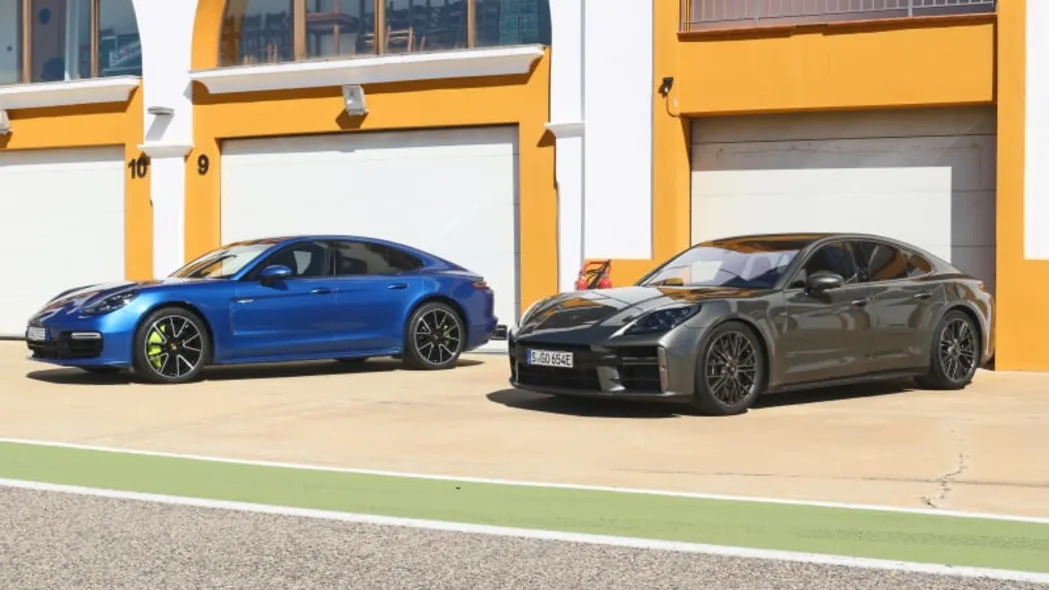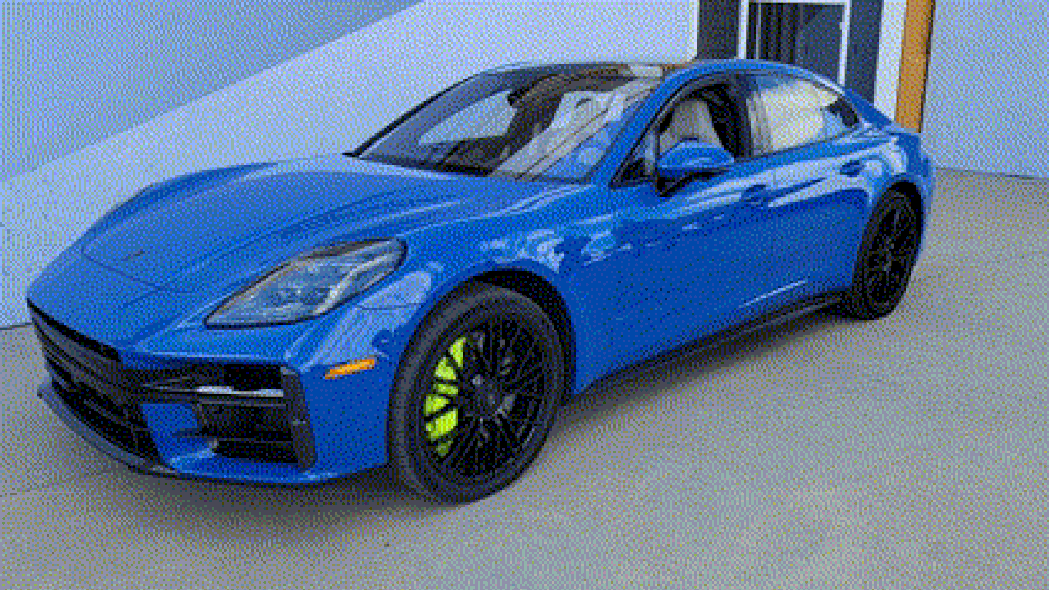SEVILLE, Spain – The Panamera has been referred to as many issues. To its stewards, it’s the Porsche of luxurious sedans. To detractors, it’s yet one more image of the once-great sports activities automotive builder’s diluted trendy mission. To its engineers, it’s an opportunity to show that the Porsche emblem represents excellence in any context, and to take action, they’re keen to do absolutely anything in need of reinventing the wheel.
At this price, humankind’s biggest mobility epiphany could also be in jeopardy too, as a result of the 2024 Porsche Panamera doesn’t appear to roll in any respect. Whereas 2024 represents solely a heavy revision of the Panamera’s basic platform, it’s additionally a fruits of a era’s price of engineering classes and technological development at a time when electrification is doling out giant helpings of each at a breakneck tempo.
However the 2024 Porsche Panamera isn’t merely a technological tour-de-force. Its engineers weren’t eager to debate ADAS or the way forward for self-driving. The Panamera could also be a luxurious conveyance, however it’s nonetheless engineered to be greatest appreciated from behind the wheel, irrespective of how attractive the upholstery on the rear split-bucket bench could also be.
Houndstooth inside or not, the Panamera isn’t a carpet within the literal sense, however its suspension is certainly magical and the specs bear out the airborne metaphor. It’ll do 0-to-60 in about 3 seconds on the best way to a high pace north of 195 mph; that’s flying, actually. However lithe aerialist, the Panamera isn’t. Its large fenders could also be designed to imitate the 911’s, however with 670 horsepower and 685 pound-feet of torque, Panamera Turbo E-Hybrid is likely to be a bit extra Höllenkatze than Carrera.
These figures might not appear far off from the final gen’s, however bear in mind, this isn’t a clean-sheet redesign. The bottom and E-Hybrid fashions are nonetheless constructed round a twin-turbo V6, whereas the Turbo E-Hybrid makes use of a V8 alongside its hybrid elements. The V8’s turbos are single-scroll models now somewhat than twins, and the PDK now has a motor inside its housing, however the common format of issues hasn’t modified all that a lot.
The actual story right here is Porsche’s new suspension — the uncommon little bit of wizardry that really makes the complexity of an adaptive suspension appear worthwhile. We’re speaking commonplace dual-chamber air suspension with the choice to improve to the Turbo E-Hybrid and its Energetic Trip, which ventures into no-anti-roll-bars ranges of silliness.
Anti-roll bars — aka stabilizer bars, sway bars, or “that stupid thing I have to drop the cradle to install” — create a bodily hyperlink between the opposing corners of a suspension. They scale back physique roll by tying the motions of the 2 corners collectively. The stiffer the anti-roll bar, the much less independently (or the extra like a stable axle) your suspension will behave.
In different phrases, anti-roll bars inherently prohibit the very benefits that make impartial suspension designs worthwhile within the first place. However with out anti-roll bars (or an equal stand-in), you find yourself with a clean however floaty — and decidedly un-Porsche-like — journey.

Fortuitously, Porsche has Porsche cash, and with Porsche cash you’ll be able to afford to switch anti-roll bars with one thing superior. What most automobiles depend on their stabilizer bars for, Porsche’s Energetic Trip can do higher, and we now have the Panamera’s new onboard 48-volt electrical structure to thank for it.
What does electrical structure should do with suspension design? Nicely, to implement a system that may independently management the air springs and hydraulic dampers concurrently whereas additionally simulating the consequences of an anti-roll bar, you want plenty of sensors, together with the bandwidth and computing energy to crunch all the information they produce. Porsche’s new 48-volt commonplace not solely offers the mandatory bandwidth, however doubles as a weight-saving measure of types. By growing the voltage (what quantities to the “speed” of electrical energy), the Panamera’s numerous sensors and modules can speak to one another at decrease latencies whereas utilizing thinner conductors. Like paint, wiring harnesses add weight.
With this improve, Porsche’s electrical engineers designed a system to work in what may as properly be real-time. The result’s a pc that is aware of what you’re doing earlier than you’re totally dedicated to doing it, permitting it to behave each reactively and predictively. With a suspension this sensible and versatile, the Panamera joins a uncommon area of interest of high-performance luxurious automobiles that don’t have anti-roll bars in any respect. McLaren made waves with a hydraulic setup that completed the identical factor within the MP4-12C and has advanced it since. Rivian’s vehicles make use of one thing comparable, as do some Mercedes choices and the Ferrari Purosangue.
However Porsche wasn’t content material with merely aping the efficiency of an uncompromised metal suspension. Porsche cash, bear in mind? The Turbo E-Hybrid’s Energetic Trip takes issues a step additional by actively pitching and rolling the chassis to counter its pure physique motions. Ever pushed a automotive that leans into a nook or noses down whereas accelerating?

Yep, it’s as spooky because it sounds, particularly the pitch management, which is able to deliver the Panamera’s nostril up throughout exhausting braking to counter the pure dive of the physique. The feeling is much like the best way an influence boat comes off a clean aircraft when the throttles are all of a sudden lower. The eeriness is amplified in a panic cease as a result of it utterly modifications the best way your physique experiences the deceleration. You hit the belts with extra pressure and you’re feeling much less of a downward tug in your legs as a result of utter absence of brake dive.
These options are disabled within the Turbo’s sporty drive modes for purpose, however we have been allowed to mess around with them throughout our lead-follow session at Circuito Monteblanco right here in western Spain. If the expertise sounds weird, seeing it in motion is even nuttier. Driving behind a automotive with each options activated is like watching the early construct of a racing sim the place someone inverted the animations from the physics engine. Up is down. Left is true. Porsche is luxurious?
Possibly, however it should first be quick. The opposite half of our observe session was spent doing extra track-appropriate issues, like seeing simply how fast this sled can go. The Turbo E-Hybrid might speed up like a sports activities automotive, however it positive doesn’t brake like one. That’s not a knock towards the {hardware}, thoughts you; these huge clampers do the job, however the best way Porsche managed to cover the Panamera’s heft on the far edges of your notion makes it tough to get a way of the automotive’s true scale. I discovered this the spicy approach after discovering a little bit of pace deeper in my session and consequently blowing the following braking zone by about 20 toes.
From behind the wheel, it’s straightforward to neglect {that a} thousand kilos separate the usual Panamera and this 670-horsepower brute, and because of its low hip level, it feels each bit the a part of a sporty GT tucked behind the 911 main our session. No try has been made at a “commanding” seating place, largely for the higher, however it does make it all of the tougher to mentally acclimate to the large Porsche’s incongruently petite angle.
The suspension remains to be exhausting at work, however somewhat than attempting to mute the automotive’s responses to the surface world, it’s doing its greatest to speak them. The result’s a combined bag. Isolation is a key element of an opulent journey; attempting to retroactively engineer “feel” again into the design with out compromising that’s difficult.
The end result (equivalent to it’s) manifests as street noise on the road and tangible communication via among the Panamera’s contact factors on observe, however with every part happening between the motive force and the pavement, you’re left to depend on your hips and shoulders greater than your arms for correct suggestions. Getting a really feel for the rear finish is straightforward, and even with stability management on, it doesn’t balk at a little bit path braking, and it responds to raise with predictable linearity.
Nevertheless it’s nonetheless simply so darned heavy. Once I in contrast it to that quasi-aforementioned Charger Hellcat, that was a bit unfair to the large Dodge. The Charger widebody checks in at round 4,600 kilos; the Turbo E-Hybrid weighs as a lot as a Hellcat with the remainder of your nuclear household already belted in. (We do not have an official determine for 2024. The present Turbo S E-Hybrid is sort of 5,300.) However not like the Charger, which possesses the kind of gravitas usually reserved for the likes of Larry the Cable Man, the Panamera leads with a degree of refinement and poise that overpromises within the different path. Consequently, the Turbo’s 670-odd horsepower simply doesn’t really feel all that quick, even with 331 pound-feet of that powertrain’s torque coming from electrical motors. Pure EV acceleration has spoiled us virtually as a lot as Hellcats have.
On the road, we get to pattern the usual Panamera and Panamera 4; a thousand kilos lighter and with solely about half the ability, they’re fairly a departure from what we obtained to toy with at Monteblanco. Because it seems, although, they’re much better suited to the Spanish countryside, which appears completely devoid of something resembling a straightaway.

The usual automotive lacks the Turbo E-Hybrid’s Energetic Trip and all of the nifty pitch and roll mitigation options that include it, however it nonetheless rides on air. There’s a definite development in firmness as you dial it up via the Sport and Sport Plus drive modes. For a nice cruise via the nation, the usual Auto mode will do exactly advantageous; even Sport Plus not often feels punishing. Porsche is luxurious?
The dual-turbo V6 makes 348 horsepower and 368 lb-ft of torque; nothing to put in writing dwelling about, however greater than satisfactory. Porsche says the Panamera 4 will hit 60 in 4.7 seconds, whereas the usual RWD mannequin wants 5.0 flat — each a lot spectacular contemplating the physics concerned. There can be extra powertrains as time goes on, with two extra mid-range hybrids coming virtually instantly. With 536 hp and 553 lb-ft, the 4S E-Hybrid seems to be to be the candy spot. The Turbo E-Hybrid will finally be dethroned by an S, however we don’t but know the way a lot energy it’ll provide.
This would be the last Panamera on this chassis, and if Porsche has left something on the desk, I can’t readily establish it. The subsequent Panamera can be electrical. Maybe not completely, however the platform’s engineers have already overtly acknowledged the inevitability. By default, that is probably the most superior ICE-based sedan Porsche has ever constructed, and due in no small half to its engineers’ dedication to journey high quality over outright efficiency, probably the most luxurious sedan the model has ever constructed. It’ll most likely be the most costly too, however we’re nonetheless just a few weeks away from studying last pricing. Regardless, Porsche has demonstrated a basic understanding of the task. Whether or not the model’s fanatics will apply the identical rubric is one other matter fully.
Regardless of the restrictions of its almost decade-old platform, the Panamera’s engineers have managed to unlock much more efficiency potential with out letting it stray from its luxurious mission. Greater than that, Porsche managed to perform this by decidedly luxurious — and dare I say, characteristically German — means. By that, I imply costly, high-tech engineering. OK, then. So Porsche actually is luxurious.

